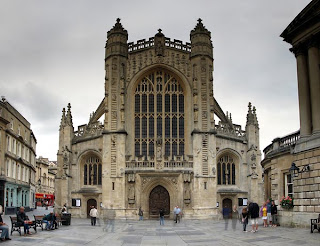After touring the Fashion Museum, I went upstairs to visit the Assembly Rooms, which were designed by John Wood the Younger in 1769 and completed in 1771. The Rooms are primarily made up of three main, public rooms – the first being the Ball Room, where balls were held twice a week, on Mondays and Thursdays.
Here is a plan of the Rooms
The plan, as well as an excellent article on English Assembly Rooms can be found on that most excellent blog, Austenonly.
The yellow Octagon Room was used for card play until the Card Room was added in 1777.
And the Tea Room was, naturally, where the fashionable went to take tea. Here is Rowlandson’s print of the Room –
It is remarkable that the Assembly Rooms exist today at all. During WWII, the historically important English cities of Exeter, Bath, Norwich and York were targeted by the Germans in a series of targeted attacks known as the Baedeker raids.
From Wikipedia: The Baedeker raids were conducted by the German Luftwaffe’s Luftflotte 3 in two periods between April and June 1942. They targeted strategically relatively unimportant but picturesque cities in England. The cities were reputedly selected from the German Baedeker Tourist Guide to Britain, meeting the criterion of having been awarded three stars (for their historical significance), hence the English name for the raids.
“Over the weekend of 25-27 April 1942, Bath suffered three horrifying reprisal raids, from 80 Luftwaffe planes which took off from Nazi occupied northern France. As the city sirens wailed few people took cover, even when the first pathfinder flares fell the people of Bath still believed the attack was destined for nearby Bristol. During the previous four months Bristol had been hit almost every night, and so the people of Bath did not expect the bombs to fall on them.
“The first raid struck just before 11 pm on the Saturday night and lasted until 1 am. The enemy aircraft then returned to France; refuelled, rearmed and returned at 4.35 am. Bath was still ablaze from the first raid, making it easier for the German bombers to pick out their targets. The third raid, which only lasted two hours but caused extensive damage, arrived in the early hours of Monday morning. The bombers flew low to drop their high explosives and incendiaries and then returned to rain the streets with machine-gun fire. 417 people were killed, another 1,000 injured. Over 19,000 buildings were affected, of which 1,100 were seriously damaged or destroyed including 218 of architectural or historic interest. Houses in the Royal Crescent, Circus and Paragon were destroyed and the Assembly Rooms burnt out.“
This is how the Tea Room looked after the Baedeker raids, or Bath Blitz, in April 1942.
And this what they look like today.
It is of interest to note that all of the rooms are today lit by their original 18th-century chandeliers, which had thankfully been taken down and placed in storage at the start of the war. For more on the history of the chandeliers and their preservation, visit author Lesley-Anne McLeod’s site here.
For further contemporary information about Regency Bath and the Assembly Rooms, read Pierce Egan’s Walks Through Bath: Describing Every Thing Worthy of Interest, published in 1819. It contains lots of detailed 1819 travel information.
And because so much of what we know and have seen of the Assembly Rooms and, indeed Bath itself, has come to us via films, especially those based upon the novels of Miss Jane Austen, you can download the Bath Movie Map here and use it as a guide to film locations throughout the City.
Part Four Coming Soon!
.























